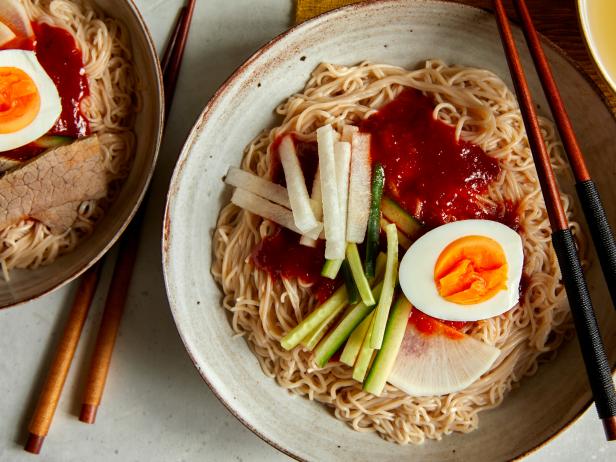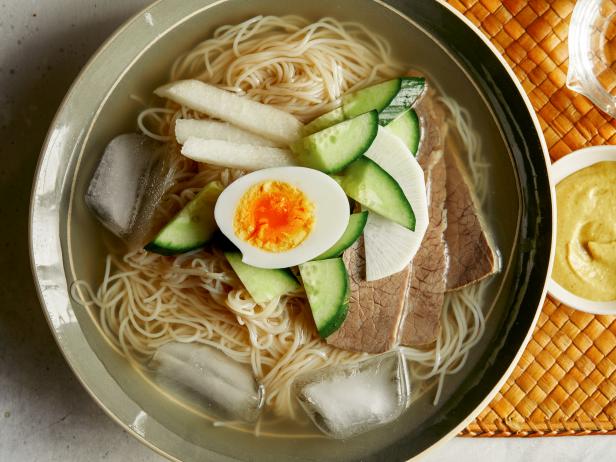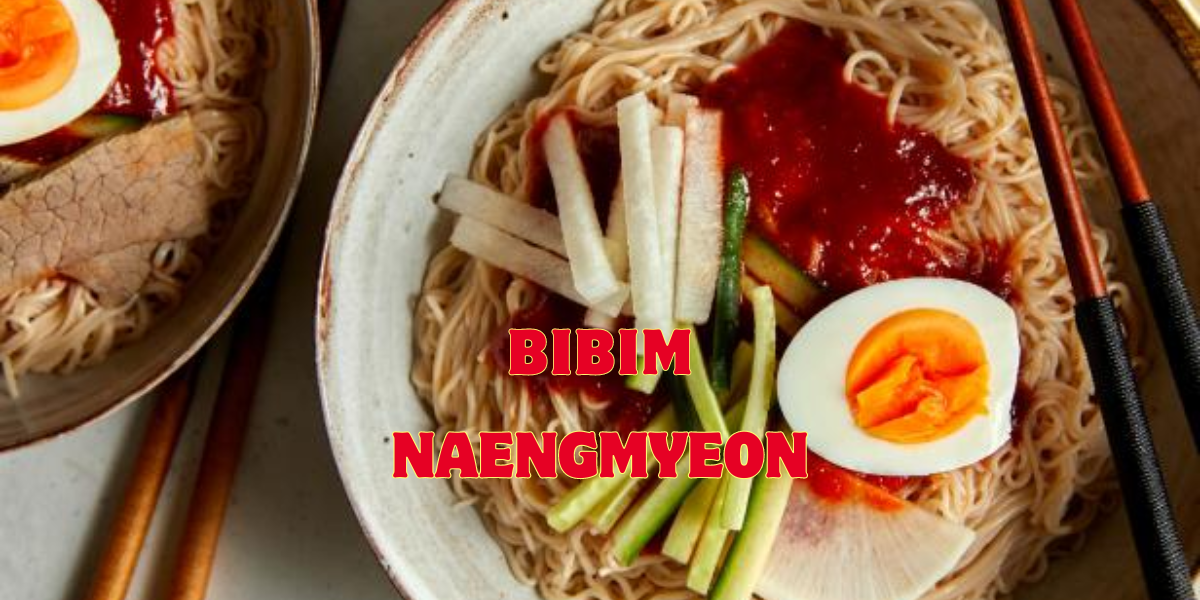Introduction
Bibim Naengmyeon, a beloved Korean cold noodle dish, is a perfect culinary delight for hot summer days. Its unique blend of chewy buckwheat noodles, spicy and tangy sauce, and a medley of fresh, crisp vegetables offers a refreshing and satisfying meal. This dish is not only a favorite in Korea but has also gained popularity worldwide. In this article, we’ll explore the history, ingredients, preparation methods, and cultural significance of Bibim Naengmyeon, along with some tips for making the perfect bowl at home.
History of Bibim Naengmyeon
Bibim Naengmyeon has its roots in North Korea, particularly in the regions of Pyongyang and Hamhung. The dish originally gained popularity during the Joseon Dynasty and was traditionally enjoyed during the winter months. However, it has evolved into a beloved summer dish due to its refreshing qualities. The Pyongyang version, known for its milder and broth-based preparation, contrasts with the Hamhung version, which is spicier and features a drier, more intense sauce.
The sauce is the most important component of bibim naengmyeon. It is a mixture of sweet, spicy, and acidic flavors that works wonderfully with the chewy noodles. Although egg and beef are typically used as toppings for this dish, our version does not include either of those ingredients in order to provide a straightforward vegan dinner.
Adding slices of fried or grilled tofu to the top of the dish will make it a more satisfying dinner. Eat this dish as soon as possible for the optimum results. After a longer period of time, the noodles become more rigid and difficult to combine.
It is common for comfort foods to be served piping hot. There are casseroles and soups that come to mind. In contrast, the cuisine that I find most comforting is bibim naengmyeon, which is a cold dish consisting of sweet, spicy, and vinegary Korean noodles.
This is suitable for those such as me, who have had a greater desire to seek sanctuary from the heat than from the cold. In the blazing heat of summer in Southern California, where my mother had immigrated and where I had spent my childhood, bibim naengmyeon offered a cooling and revitalizing flavor of Korean cuisine.
Given its distance from the cooling force of the ocean or the mountains, the San Fernando Valley has some of the highest temperatures in Los Angeles. Although the Valley does not have the same level of humidity as Seoul, it does have some of the highest temperatures.
When we were thirsty, my mother and I would turn to summery pleasures such as mung bean popsicles, chilled soups, and cold yogurt beverages. These are foods that can fulfill the soul while also quenching the thirst. I thought that bibim naengmyeon was the most promising. Not only do I think of it in terms of kitchen tables, but I also think of food courts that are attached to Korean supermarkets.

In many respects, it is a dish that is not complicated. A dish that is wonderfully messy is one that is made by vigorously mixing the ingredients together right before food is consumed.
(“Bibim” is a Korean word that means “mixed,” as in bibimbap, which is a type of rice that is blended.) And it is difficult to maintain an air of sophistication while slurping from a heaping bowl of noodles, which leave behind an oily red mark around the lips and a foul odor in the air.
On sticky days, Bibim naengmyeon is a kind of discussion that lends itself to lengthy and unhurried exchanges. Because there is no risk of it melting or cooling, there is no feeling of urgency to consume it as quickly as possible.
In addition, it is a starchy meal that is satisfying without being overly heavy. This is because the noodles are made with a combination of buckwheat flour and (often) sweet potato starch, which gives them its chewiness characteristic.
This dish does not require a significant amount of time spent in a hot kitchen. In a matter of minutes, the sauce can be put together, while the noodles may be cooked in a short amount of time.
Following my departure from Southern California, I have resided in a number of locations where the availability of Korean components is significantly lower than it was in the Korean minority enclave where I was raised. When I first became aware of how much I had taken for granted the convenience of having access to Korean things, it was a shocking realization.
My mother used to give me care packages that were filled with seaweed and other lightweight goods while she was concerned about the cultural shock that I would experience. She did this in the expectation that the weight of the boxes would be reduced. Indeed, there were instances in which the costs of shipping were higher than the worth of the items being shipped.
However, regardless of the distance, bibim naengmyeon has been by my side in some capacity throughout the entire process. It has served as a concrete reminder of the various homes that immigrant families eventually come to inhabit, which is a reflection of the fact that for many people, a migratory trip is never really completed and is, in some respects, a process that continues throughout consecutive generations.
As a result, in the course of my own travels, I have prepared non-traditional variations of this dish in almost every place that I have resided. However, a typical Korean pantry would already include all of the items, which would eliminate the need for additional trips to the grocery store.
Gochujang, a spicy-sweet paste that is used in a variety of Korean foods, is the most essential component; nevertheless, if I am unable to locate gochujang, I will substitute Sriracha for it. In the event that I am unable to obtain sesame oil, I will substitute olive oil and use a substantial amount of sesame seeds. Instead of naengmyeon noodles, you might use soba noodles as an alternative. Even if I were to be completely forthright, I would not be able to differentiate between rice vinegar and other varieties of white vinegar when it comes to this dish.
Due to the fact that I am now vegan, I no longer opt for sliced eggs with beef on top; however, fried tofu slices are a wonderful alternative. In addition, although I typically use cucumbers, carrots, or zucchini to make a swirling motion in the noodles, a wide variety of other veggies would also work excellently. When it comes to creating it, I must confess that I have never bothered to include pear or radish pieces, despite the fact that other recipes do include them.
It’s possible that purists will be horrified by this recipe, but I find that the beauty of it comes in the fact that it is both simple and versatile. Therefore, it is fitting that my version is a kind of hybrid of two dishes that are comparable to tossing noodles: bibim naengmyeon, which has noodles made from buckwheat mix, and bibim guksu, which has a basic sauce.
The mixed Korean nature of my own upbringing and family, which is now a blend of Mexican, Apache, Filipino, and North and South Korean families, is reflected in this borrowing. In the same way that this huge dish of noodles is bibim, my family most certainly is. And regardless of the weather, it is a source of comfort.

Ingredients
The key to an authentic Bibim Naengmyeon lies in its ingredients. Here are the essential components:
- 1 pound naengmyeon noodles (see Note) or soba noodles
- 3 tablespoons gochujang
- 3 tablespoons rice vinegar
- 3 tablespoons agave syrup, maple syrup, honey or brown sugar
- 3 tablespoons reduced-sodium soy sauce
- 3 tablespoons sesame oil
- 3 cloves garlic, minced
- 1 English cucumber, cut into matchsticks
- 2 tablespoons toasted sesame seeds
- Fried tofu slices (optional)
- Pickled radish slices (optional)
- Chopped green onions (optional)
- Noodles: Made primarily from buckwheat and sweet potato starch, these noodles are thin, chewy, and resilient. They are typically darker in color due to the buckwheat.
- Sauce: The spicy sauce, or “bibim” sauce, is a mix of gochujang (Korean red chili paste), vinegar, sugar, garlic, and sesame oil. The balance of sweetness, tanginess, and heat is crucial.
- Vegetables: Common vegetables include julienned cucumber, Korean pear, and radish. These add a refreshing crunch and contrast to the spicy sauce.
- Protein: Slices of boiled beef, or sometimes marinated raw fish, are added for protein. Hard-boiled eggs are a classic topping.
- Garnishes: Sesame seeds and nori strips often garnish the dish, adding extra flavor and texture.
Preparation
Making Bibim Naengmyeon at home requires attention to detail to achieve the perfect texture and flavor balance. Here’s a step-by-step guide:
- Noodle Preparation: Cook the noodles in boiling water until they reach a chewy texture. Rinse them in cold water immediately to stop the cooking process and enhance their chewiness.
- Sauce Preparation: Mix gochujang, vinegar, sugar, garlic, and sesame oil in a bowl. Adjust the proportions to suit your taste preferences.
- Vegetable Preparation: Julienne the cucumber, pear, and radish. These should be thinly sliced to blend well with the noodles.
- Protein Preparation: Boil the beef until tender, then slice it thinly. Alternatively, prepare marinated raw fish if preferred.
- Assembly: Place the cold noodles in a bowl. Top with the prepared vegetables, protein, and hard-boiled egg halves. Drizzle the spicy sauce over the top.
- Garnishing: Sprinkle with sesame seeds and nori strips.
Cultural Significance
Bibim Naengmyeon holds a special place in Korean cuisine and culture. It is often enjoyed during special occasions and celebrations. The dish is not just about satisfying hunger but also about bringing people together. Its communal aspect is seen in the way it is shared among family and friends, emphasizing harmony and unity.
In North Korea, Naengmyeon is often referred to as a “reunification dish,” symbolizing the hope for reunification between North and South Korea. This cultural significance adds depth to the enjoyment of the dish, making it more than just a meal but a symbol of Korean heritage and aspirations.

Variations and Regional Differences
While the basic components of Bibim Naengmyeon remain consistent, there are regional variations that highlight local tastes and ingredients:
- Pyongyang Naengmyeon: Known for its milder, broth-based version with a subtle, refreshing taste.
- Hamhung Naengmyeon: Spicier and often drier, with a more intense flavor profile.
- Milmyeon: A variant from Busan, using wheat noodles instead of buckwheat, offering a different texture and taste.
Each variation reflects the unique culinary traditions of its region, contributing to the rich tapestry of Korean cuisine.
Tips for Making the Perfect Bibim Naengmyeon
Achieving the perfect Bibim Naengmyeon at home can be a rewarding experience. Here are some tips to ensure your dish is as authentic and delicious as possible:
- Noodle Texture: The noodles should be cooked until they are chewy but not mushy. Rinsing them in cold water is crucial to achieving the right texture.
- Sauce Balance: Adjust the sauce ingredients to find the perfect balance of spicy, sweet, and tangy flavors. Taste as you mix to get it just right.
- Fresh Ingredients: Use fresh, high-quality vegetables and protein. The crispness of the vegetables adds a refreshing contrast to the chewy noodles.
- Chill Everything: Ensure that all components, especially the noodles and sauce, are well-chilled before assembling the dish. This enhances the refreshing quality of the meal.
- Presentation: Arrange the toppings beautifully for an appealing presentation. A visually pleasing bowl enhances the dining experience.
Serving Suggestions
Bibim Naengmyeon is often served with additional side dishes, known as “banchan,” to complement its flavors. Popular banchan options include:
- Kimchi: The spicy, fermented cabbage pairs perfectly with the cool, spicy noodles.
- Pickled Radish: Adds a tangy, crunchy element to the meal.
- Cucumber Salad: A light and refreshing side to balance the heat of the dish.
Serving Bibim Naengmyeon with these sides enhances the overall dining experience, providing a delightful contrast of flavors and textures.
FAQs
What is Bibim Naengmyeon?
Bibim Naengmyeon is a Korean cold noodle dish made with chewy buckwheat noodles, a spicy and tangy sauce, and a variety of fresh vegetables and protein toppings. It’s typically enjoyed during hot weather due to its refreshing nature.
How is Bibim Naengmyeon different from Mul Naengmyeon?
While Bibim Naengmyeon is served with a spicy, gochujang-based sauce and no broth, Mul Naengmyeon is served in a cold, vinegary broth, often made with beef or dongchimi (radish water kimchi). The main difference lies in the sauce versus the broth.
What are the main ingredients in Bibim Naengmyeon?
The key ingredients include:
- Buckwheat noodles (Naengmyeon noodles)
- Spicy sauce (gochujang, vinegar, sugar, garlic, and sesame oil)
- Fresh vegetables (julienned cucumber, Korean pear, and radish)
- Protein (boiled beef slices or marinated raw fish)
- Garnishes (hard-boiled egg, sesame seeds, and nori strips)
How do you make the spicy sauce for Bibim Naengmyeon?
The spicy sauce typically includes:
- 3 tablespoons of gochujang (Korean red chili paste)
- 2 tablespoons of vinegar
- 1 tablespoon of sugar
- 1 teaspoon of minced garlic
- 1 tablespoon of sesame oil Mix all these ingredients together, adjusting to taste.
Can Bibim Naengmyeon be made vegetarian or vegan?
Yes, Bibim Naengmyeon can easily be made vegetarian or vegan by omitting the meat and egg. You can add more vegetables or use plant-based protein alternatives like tofu.
What is the best way to cook Naengmyeon noodles?
Boil the noodles according to the package instructions, usually for about 3-4 minutes. Immediately rinse them under cold water to stop the cooking process and achieve a chewy texture. Rinse thoroughly to remove any excess starch.
Is Bibim Naengmyeon spicy?
Yes, Bibim Naengmyeon is known for its spicy sauce. However, you can adjust the level of spiciness by altering the amount of gochujang used in the sauce.
What are some common side dishes served with Bibim Naengmyeon?
Common side dishes, or banchan, include:
- Kimchi
- Pickled radish
- Cucumber salad These sides complement the flavors of Bibim Naengmyeon and add variety to the meal.
Can I make Bibim Naengmyeon ahead of time?
You can prepare the components ahead of time, such as the sauce and vegetables. However, it’s best to cook and rinse the noodles just before serving to ensure they retain their chewy texture.
What are some variations of Bibim Naengmyeon?
There are regional variations like:
- Hamhung Naengmyeon: Known for its drier, spicier preparation.
- Pyongyang Naengmyeon: Typically served with a milder, broth-based version but can be adapted with a spicy sauce.
- Milmyeon: Uses wheat noodles instead of buckwheat, popular in Busan.
What does Bibim Naengmyeon symbolize in Korean culture?
Bibim Naengmyeon symbolizes harmony and unity. In North Korea, it’s often seen as a “reunification dish,” representing the hope for reunification between North and South Korea.
Where can I buy Naengmyeon noodles and ingredients?
Naengmyeon noodles and ingredients are available at Korean grocery stores and online. Look for buckwheat noodles, gochujang, and other Korean condiments in the international foods section.
How is Bibim Naengmyeon traditionally served?
Bibim Naengmyeon is traditionally served in a large, shallow bowl with the noodles in the center, topped with sauce, vegetables, and protein. It’s garnished with sesame seeds and nori strips, with the sauce mixed in before eating.
Is Bibim Naengmyeon healthy?
Bibim Naengmyeon can be a healthy dish as it is low in fat and high in fiber due to the buckwheat noodles and vegetables. However, the sodium content can be high due to the gochujang and other seasonings, so it should be enjoyed in moderation.
Conclusion
Bibim Naengmyeon is more than just a dish; it’s a cultural icon and a testament to the rich culinary heritage of Korea. Its unique combination of flavors, textures, and the refreshing quality makes it a favorite for many. Whether enjoyed in a traditional Korean restaurant or prepared at home, Bibim Naengmyeon offers a delicious and satisfying meal that brings people together.
By understanding its history, mastering the preparation techniques, and appreciating its cultural significance, you can truly savor the essence of Bibim Naengmyeon. So, the next time you crave a refreshing and flavorful meal, consider diving into a bowl of this iconic Korean cold noodle dish.

